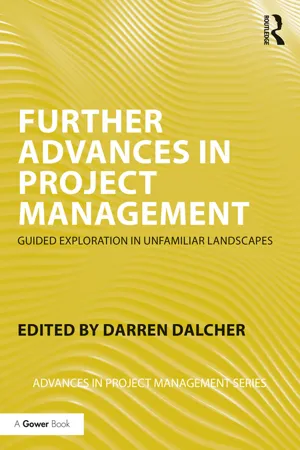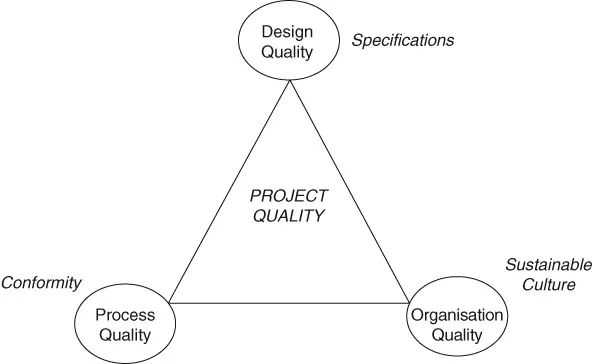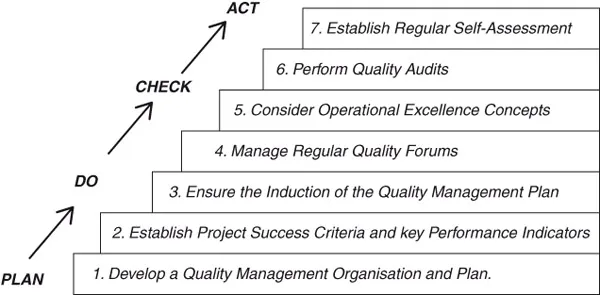![]()
1 Quality
![]()
From quality to the pursuit of excellence
Darren Dalcher
Quality is an elusive concept and topic. Much has been said and done in the name of quality, but the underlying features of quality are yet to generate universal agreement.
Philip Crosby, a major contributor to the quality management movement, asserted that ‘quality is free’. His book with the same title published in 1979 made a strong case for doing it right the first time. The idea is simple: if you do things right in the first place, you will not need to pay to fix them, or be forced to re-do them later which would lead to added costs and the loss of reputation and hard-earned trust. The case for getting things right from the outset is compelling, as recent recalls of cars and the grounding of new fleets of aeroplanes demonstrate.
Quality has proved to be a prolific pre-occupation for philosophers, as well as industrialists. Indeed, some of the ancient Greek philosophers long recognised that quality is not a single act but a habit.
One of the bestselling books dedicated to exploring the boundaries and meaning of quality is Robert Pirsig’s Zen and the Art of Motorcycle Maintenance published in 1974. The book has sold over 5 million copies worldwide and is acclaimed as the most highly read book of philosophy ever written. It also holds the distinction of having been originally rejected by 121 publishers, more than any other bestselling book according to the Guinness Book of Records.
Pirsig’s book, recounting a journey on a motorcycle across the US, can be read at many different levels. It can be viewed as a travel odyssey, a treatise on the philosophy of life, an exploration of familial relationships or most crucially a deep philosophical discussion on the meaning of quality. The main character in the book is gradually introduced through a series of flashbacks as a former university professor who spent his life pursuing a quest for the true meaning of quality. The closer he got to a true definition of the term, the more unstable and chaotic his personal situation became. Finally, just as he was close to defining the meaning that he was seeking, he became mentally unstable. As the book begins, the hero tries to recover from the trauma and embarks on a physical journey of discovery. Pursuit of the true meaning of quality thus appears to have cost him his sanity.
However maddening, the notion of quality is central to organisations, to projects and to management. It hinges on stakeholders and their perceptions, on design quality, fitness for use, conformance to requirements and on meeting the expectations of customers. Over the years, the original focus on quality, which featured a production-centric interest, has been augmented by additional perspectives and viewpoints that increasingly feature individuals and their interests. Understanding quality requires the multidimensional and dynamic juxtaposing of ideas and concepts in search of value.
Indeed, any definition of quality would require an understanding of the importance of people, and their place within the organisation. The chapter by Ron Basu is derived from his book Managing Quality in Projects, which is part of the Advances in Project Management series, published by Gower. Far from maddening, Basu seeks to identify and highlight the underpinning principles of quality in projects. His approach offers new perspectives on the definition of the dimensions of quality in project management, and makes a powerful case for utilising models of project excellence, whilst recognising the crucial role of project stakeholders.
Ron’s perspective offers a rich contribution to good practice and the wider project management literature by hinting at the need for an organisational take on the role of quality in projects. The focus on critical factors and organisational maturity encourages a deeper understanding of the roots and implications of quality, which are essential to improving the performance of major projects.
US industrialist Henry Ford noted that: ‘quality means doing it right when no one is looking’. Quality can clearly mean different things to different people. It can certainly be interpreted and implemented in different ways and hence is in the eye of the beholder. Nonetheless, quality relates to the degree of excellence that an item, product, system or organisation encompasses. This implies greater attention to the set of attributes that dynamically contribute to the development of quality as excellence. The English art critic John Ruskin observed that: ‘quality is never an accident. It is always the result of intelligent effort.’ Striving for excellence can be part of our orchestrated and intelligent effort to make quality central to every endeavour and undertaking whilst ‘doing it right from the start’. It can also play a key part in re-positioning the discourse on quality around the pursuit, and achievement of excellence.
References
Basu, R. (2012) Managing Quality in Projects, Farnham: Gower.
Pirsig, R. M. (1974) Zen and the Art of Motorcycle Maintenance: An Inquiry into Values, London: Bodley Head.
![]()
The best practices of managing quality in projects
Ron Basu
Why project quality?
We all agree and accept that as an end user of a product or service we would like it ‘as it says on the tin’, when we want it and at good value for money. Being in a competitive world of consumer choice we also expect it to last. This is the domain of operations, services and supply chain management. And we define it as ‘quality is the consistent conformance to customer experience’ (Basu, 2011). However in the field of project management the importance of quality is not so clear cut. Project managers appear to accept the ‘iron triangle of cost, time and quality’ (Atkinson, 1999) but focus more on ‘on time and budget’ delivery as the success criteria. Quality in projects is mostly relegated to a ‘lip service’ and to several documents with ‘ticking boxes’. As a consequence we find many examples of projects (such as Wembley Stadium, Millennium Dome, West Coast Rail Upgrade) which were delivered on time and within budget but failed to meet the expectations of end users. Therefore we need to ask ‘how diligent are we in terms of project processes to deliver project objectives’? This is the minimum requirement of ‘what it says on the tin’. Furthermore we should also investigate ‘how good is our project management … as a vehicle for delivering the longer term outcomes and benefits as required by the sponsors and end users’.
Filling the gap of the ‘Iron Triangle’
There appears to be a knowledge gap in the environment of project management related to the benefits achieved by quality management in comparison to the manufacturing and service operations. The book that inspired this article (Basu, 2012) is an attempt that sets out to investigate the impact of all aspects of quality in project management. The author’s investigation focuses initially on defining the dimensions of quality in project management and identifying sources of measurement for project excellence. He expands to discuss which tools can be used in the quest for project excellence; and the factors and processes critical to project success and maturity. The text also explores how the successes of supply chain management, Lean Thinking and Six Sigma may be gainfully deployed. In this book, an extensive review of the publications written about managing quality in projects and bodies of knowledge (e.g. PMBOK Guide, PRINCE2) was underpinned by field research and two contemporary case studies (viz. Heathrow Terminal 5 and High Speed 1). A structured implementation of project quality, by those directly involved in project delivery and the project stakeholders for achieving a sustainable outcome of the project, is also a valuable contribution of this book, and the specific steps of that approach are described below.
Definition of project quality
Basu (2011) proposes a three-dimensional model of quality, shown in diagrammatic form in Figure 1.1.
The product quality should contain defined attributes of both numeric specifications and perceived dimensions. The process quality should also contain some defined criteria of acceptable service levels so that the conformity of the output can be validated against these criteria. Perhaps the most important determinant of how we perceive sustainable quality is the functional and holistic role we fulfil within the organisation. It is only when an organisation begins to change its approach to a holistic culture emphasising transparent measurement and communications with key holders that the ‘organisation quality’ germinates.
Figure 1.1 Three dimensions of quality
Implementing quality in projects
Drawing on the case studies of Heathrow Terminal 5 and HS1, the High Speed Chunnel Tunnel rail link between London and the Kent Coast, Basu (2012) offers a proven pathway for implementing a quality management programme in major projects from the start of the initiative to the closure of the project embedding of the change to a sustainable organisation-wide culture. The framework of a quality management programme is shown in Figure 1.2 and described below. Note the emphasis on each step of the programme could vary depending on the type, size and complexity of the project.
Step 1: Develop a Quality Management Organisation and Plan
A key task for the project board is to appoint an independent Quality Manager reporting to top management as early as possible. Our experience is that it is essential to allocate a quality budget (over 0.5% of project spend) and convince at least a third of the Board with the scope and benefits of project quality, before launching the quality management plan. The objectives of a quality management plan should aim to provide assurance that assets are safe, reliable and meet quality requirements (product quality) and also to work efficiently and effectively so that products are delivered on time and budget (process quality). An implicit objective is also to ensure that the requirements are understood and accepted by key stakeholders (organisation quality).
Figure 1.2 Framework of a Project Quality Strategy implementation
Step 2: Establish Project Success Criteria and Key Performance Indicators
The success criteria of the project should be agreed with the Sponsor and key stakeholders at the start of the project and further grouped into the ‘four perspectives’ of the Balanced Scorecard (Kaplan and Norton, 1996) as shown below:
- Financial Perspectives
- - Commercial success
- - Meets budget
- Customer Perspectives
- - Meets user requirements
- - Achieves purpose
- Internal Processes Perspective
- - Meets time scale
- - Meets quality
- Learning and Growth Perspective
- - Happy users
- - Happy team
Step 3: Ensure the Induction of the Quality Management Plan
Having developed the Quality Management Plan and Key Performance Indicators the next stage is to ensure that key stakeholders understand and agree with the requirements in the plan and the metrics. The induction programme could be conducted in two levels. First organise a half-day workshop to introduce the plan and indicators to the Project Board and the senior members of the first tier suppliers. This should be followed by a number of one-day workshops for team members from the Client organization and major suppliers. It is expected the details of the both the quality plan and Key Performance Indicators, with omissions and inclusions, would be refined during the induction sessions.
Step 4: Manage Regular Quality Forums
Induction workshops are one-off at the early stage of the project while Quality Forums should be conducted at regular intervals, usually every month, during the total life cycle of the project. Quality Forums are organised and led by the Quality Managers and participants include Project Manager, Team Leaders and Quality Leaders, from both the Client and Major Suppliers.
A Quality Forum not only ensures communications and agreement of key stakeholders of quality issues from the same page but also helps to inculcate a quality culture across the project organization.
Step 5: Consider Operational Excellence Concepts
There are three main concepts of operations excellence which are successfully being applied in managing project quality and project excellence and these are:
- Excellence Models
- Supply Chain Management
- TQM, Lean and Six Sigma
Excellence Models form a part of regular self assessment and are covered in Step 7. Supply Chain Management (SCM) can reside as function on its own but it is important to establish a close interface between SCM and Quality Management especially related to the procurement of goods and services.
TQM, Lean and Six Sigma are inter-related concepts and inextricably linked to the management of quality in projects. These concepts are now merged into Lean Sigma or FIT SIGMA initiatives and the application of Lean Sigma or FIT SIGMA (Basu, 2011) in ...


